
What are the trends going on with snow mold in research?
Snow mold is a totally different animal than other kinds of turf diseases. They’re pretty difficult to work with in a lab, and it takes such a long time to study, so there’s not a lot of research that goes on. I do know there are some studies about the effects of potassium on snow mold being done, and the length of time that fungicides last through the winter. I’m not sure I’m seeing any specific trends in the research, though. There’s been some timing issues we’ve seen.
What kind of issues?
The question is when is the right time to put down your fungicide application? We’ve been asking if the closer to the snow cover coming down the better for handling the snow mold, but that’s not what we’re finding. We have shown in our research that it’s not really the best thing. I’m not saying the fungicide has to go down in September, that’s detrimental too, but they don’t have to go down as the snow comes down either.
We’ve suggested putting down another application earlier on than the original time. It could be anywhere from early to late October, with the second application coming closer to the actual snowfall event. The thing is, with that first application, we want to knock down the initial growth of the fungus, three to four weeks before the first snow event.
Snow mold can get started that early?
The fungus is usually starting to affect the plant well before we’ve put that fungicide down. If we only do one late application just prior to the snowfall, we’re missing some of the initial infection. It can seem like a lot, but it also has some preventative impact on similar fungi. So the benefit there is you can even get some dollar spot control while you’re starting on snow mold.
What type of fungicide should superintendents use to combat snow mold?
We get that question all the time, especially since last year with the stop sale order on PCNB. There are better snow mold products out there than PCNB, but not as many cost-effective ones. But there are a lot of different options for superintendents. The thing to know first is what you really need. Where’s the course located, and what kind of climate and pressure is there? Do they need to have excellent control of snow mold, or can they get away with 10 to 15 percent around the course? Where on the course is the snow mold showing up?
There’s no one great ingredient that’s going to give you really good control of snow mold. But I think if you mix two or three, you should be able to get good control. I think you can get away with three active ingredients and do fairly well.
What are some things to remember when preparing for snow mold?
The tough thing about snow mold is that you only get one shot at it. You can’t go out in December or January and put down more fungicide – once it snows you can’t really go out and do much about it. Make sure you have the right products for your course going down to begin with.
If you’re going to put a cover down to prevent desiccation or ice damage, you want to make sure you have a really good fungicide program. You’re going to be trapping moisture in there to help protect the turf, but that creates a great environment for the fungus.
Latest from Golf Course Industry
- From the publisher’s pen: Conscientious of a bigger role
- Bernhard and Company partners with Laguna Golf Phuket
- Terre Blanche showcases environmental stewardship
- VIDEO: Introducing our December issue
- Bernhard and Company introduces Soil Scout
- Nu-Pipe donates to GCSAA Foundation’s Centennial Campaign
- GCSAA enhances golf course BMP tool
- Melrose leadership programs sending 18 to 2026 GCSAA Conference and Trade Show





